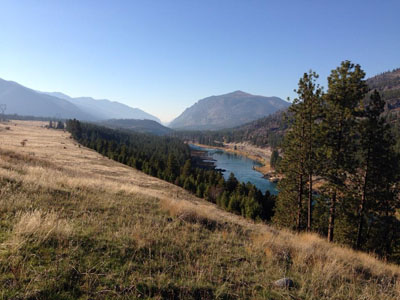Barrel Length, Velocity and Accuracy Question
January 23, 2015 2:48 amA common barrel question goes something like this: What is the longest length barrel I can get for maximum velocity? This is a good question but it isn’t quite as simple as that. Perhaps a better question would be; what is the longest accurate barrel I could use?
Many shooters are interested in getting maximum velocity at long range. And long range means different things to different people. For some it might be a 400 yard shot at an antelope while lying in the sage brush. For others it might be a 1000 yard shot at a big whitetail buck setup with sandbags and a laser rangefinder.

On this bench a close shot would be 200 yards and we can shoot on out to a mile. The whitetails like to come out of the timber and feed in the grass.
So how do we get high velocity at long range? There are several common ways. Shooting a high ballistic coefficient bullet translates into higher velocities at longer yardages. Using slow powders with heavy bullets helps too. And the other way to get ‘free’ velocity is adding barrel length. The latter is the point of this article.
There is no argument that adding length means increasing velocity. The powder gases push on the bullet for a longer duration and that means the bullet leaves the barrel at a higher muzzle velocity. This is especially true of slow powders. At some length there is a point of no additional gain and adding length will probably slow the bullet down. That length is going to depend on the cartridge capacity, bullet weight and type of powder. That said though, in my experience that point-of-no-return is going to be over 40” with the types of cartridges and powders we commonly use.
Depending on the powder, cartridge capacity and bullet weight, it is normal to see a maximum additional velocity gain of about 25 fps per inch of barrel. The amount of gain decreases as barrel length increases also.
The problem that develops is that a long barrel is less stiff than a short barrel. That idea is explained in this article. If we make a barrel that is long and skinny it is not going to be very accurate. So a long barrel should also be a heavier profile barrel to overcome this problem. But many actions will not support a heavy barrel well and stock bedding problems and vertical grouping may show their ugly head. In my opinion a barrel over about 10 pounds is going to start to cause problems on most conventional factory actions, like a Remington 700, and custom actions that are basically clones of the Remington.
A 10 pound barrel is still a heavy barrel. A 1.250” diameter barrel that is 30” long will be in this weight range. Barrels over 30” are getting in the too-long category in my opinion for many of these smaller actions with a magazine cutout.
Big actions, like those used for the .50 BMG and similar cartridges will support much heavier barrels and it is common to have longer barrels.
Bedding the barrel and bedding blocks help with long barrel stiffness issues. But those solutions can cause their own potential problems. Bedded barrels can be touchy with shooting hold or positioning on sandbags. Barrel blocks add more weight and may necessitate a change in the stock design.
With the accurate laser rangefinders, ballistics programs and excellent scopes available today, it is easy to dial in the scope adjustment needed for any velocity and ballistic coefficient combination. Getting an extra 100 fps by adding four inches of barrel length might actually be a step backwards in being able to hit the target at long range if the barrel is too whippy.

